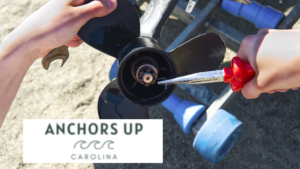Routine maintenance, without question, keeps your boat looking new and running soundly. Importantly, following a maintenance schedule will keep you on track to avoid long gaps in service. If you’re a boat owner, you need to know the 10 most essential boat maintenance routines. Unquestionably, they will help keep you on the water and out of the service center.
Change The Fuel Filter
The fuel filter on a boat motor is important because it helps to remove water and contaminants contained within the gasoline or diesel.
Fortunately, fuel filters are accessed with ease, no matter if it is an inboard, outboard, or inboard/outboard engine. Your fuel filter maintenance routine should include inspecting monthly and changing annually or per your engine owner manual.
Replace The Engine Oil
Similar to a car, the oil in an engine must be replaced after a specified number of hours compared to miles.
Marine engine oil is critical in keeping moving parts lubricated while the motor is running. For this reason, swapping out old engine oil for fresh engine oil must be done to prevent the engine from seizing.
I recommend consulting your engine manual. Change the engine oil based on the specified number of hours of run time.
Drain And Fill The Lower Unit Gear Oil
Lower unit oil is similar in its functionality when compared to boat motor oil. Instead, lower unit oil for outboards and inboard/outboards lubricates the gears.
Often, lower unit gear oil is overlooked by boat owners who perform their own maintenance. However, like engine oil, the lower unit oil will break down and become less effective.
I recommend changing the lower unit oil on an annual basis. However, if you notice milky oil or metal specs, the engine must be brought to a mechanic. Without a doubt, these are signs of serious trouble.
Swap The Spark Plugs
Importantly, the spark plugs play a critical role in combustion. The plugs ignite the fuel-oxygen mixture, thus powering the engine to propel the boat through the water.
Unfortunately, fouled plugs do not work efficiently, thus decreasing engine performance and increasing fuel burn.
With that said, the spark plugs should be removed and inspected annually. Furthermore, they should be replaced per the engine manual or whenever they appear fouled.
Wash And Cover The Boat
The accumulation of dirt and salt in coastal waters is detrimental to the finish of boats. No matter if it is vinyl, fiberglass, paint, or metal, debris should not be allowed to sit on surfaces for extended periods of time.
Comparatively, if the boat is used or not used, it should be washed. Remember, a boat that is left sitting covered or uncovered will become dirty. Wash the boat weekly when it is stored to prevent dirt from becoming embedded in the paint.
After each use, wash away salt, sand, fish blood, or other contaminants. Once the boat is cleaned, allow it to dry and cover.
Apply Wax
Waxing a vessel is important because it adds a protective layer to paint, stainless, and other surfaces.
Importantly, a layer of wax prevents dirt and salt from penetrating gelcoat and paint. On stainless, metal wax reduces the likelihood of corrosion from forming.
I highly recommend applying wax at a minimum of every six months. Once the water fails to bead up on waxed surfaces, it is time to reapply.
Clean The Bilge Pump
The bilge pump is one of the most important pieces of safety equipment hard-wired to the batteries.
Importantly, the pump serves the purpose of removing water from the lowest point of the boat as it accumulates.
Boaters often fail to realize that bilge pump housings become clogged. One of the biggest culprits of clogged bilge pumps is dog hair.
I recommend spraying the base of the pump with a hose on a monthly basis. The pressure from the hose will clear the pump of any debris. Ensure that the water poured into the bilge pumps out over the side with ease and shows no signs of restriction.
Flush The Motor
Flushing a boat motor is particularly important when the vessel is used in saltwater. Unfortunately, failing to flush a motor can lead to internal corrosion.
Unquestionably, engine damage as a result of failing to flush out saltwater is costly to repair.
Each time the motor is run in salt water, the motor should be flushed for a minimum of 5 minutes. The flushing removes salt particles.
Inspect Wiring Connections
Whether you are running your boat in saltwater or freshwater, wire connections are prone to corrosion.
Remember, boats are subject to high levels of moisture, especially within enclosures. The moisture is a catalyst for the onset of corrosion. As wires deteriorate, they become brittle and break.
Importantly, a broken connection can lead to losing essential onboard equipment. The equipment includes chart plotters, VHF radios, the bilge pump, and more.
I suggest inspecting the wiring connections every three months. Avoid a problem before it starts.
Keep Up With Your Life Saving Equipment
Life-saving equipment goes beyond life jackets, which also includes flares, throwable devices, horns, and more.
Safety, of course, is of the utmost importance. For this reason, it needs to be inspected regularly. Remember, flares expire, so you don’t want to be left with a signal that no longer functions.
Additionally, life jackets and throwables become torn or covered in mold and may require replacing. Lastly, the horn must function properly to alert other boaters.
I suggest inspecting the safety equipment monthly to be sure that you, your friends, and your family will remain safe.
Follow Boat Maintenance Routines
Remember, keeping up with maintenance will not only save you money but help prevent running into a preventable situation. As a former captain, I know maintenance well. Without question, add these 10 items to your routine maintenance schedule. I did it with my boat and did it at work.







